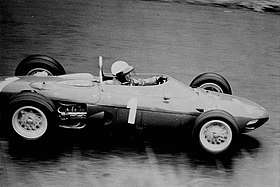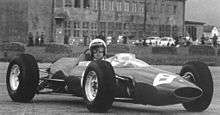Ferrari 156 F1
The Ferrari 156 was a racing car made by Ferrari in 1961 to comply with then-new Formula One regulations that reduced engine displacement from 2.5- to 1.5-litres, similar to the pre-1961 Formula Two class for which Ferrari had developed a mid-engined car also called 156 F2.
 | |||||||||
| Category | Formula One | ||||||||
|---|---|---|---|---|---|---|---|---|---|
| Constructor | Ferrari | ||||||||
| Designer(s) | Carlo Chiti | ||||||||
| Predecessor | 246 F1/246 P | ||||||||
| Successor | 158 | ||||||||
| Technical specifications | |||||||||
| Chassis | Tubular Spaceframe | ||||||||
| Engine | Ferrari Type 178, 1,476 cc (90.1 cu in), 120° V6 2 valves per cylinder DOHC, naturally aspirated Mid-engined, longitudinally mounted | ||||||||
| Transmission | Ferrari Type 543/C 5-speed manual | ||||||||
| Fuel | Shell | ||||||||
| Tyres | Dunlop | ||||||||
| Competition history | |||||||||
| Notable entrants | Scuderia Ferrari FISA Scuderia Sant Ambroeus | ||||||||
| Notable drivers | |||||||||
| Debut | 1961 Monaco Grand Prix | ||||||||
| |||||||||
| Constructors' Championships | 2 (1961, 1964)[1] | ||||||||
| Drivers' Championships | 1 (1961 – Phil Hill) | ||||||||
| n.b. Unless otherwise stated, all data refer to Formula One World Championship Grands Prix only. | |||||||||
Phil Hill won the 1961 World Championship of Drivers[2] and Ferrari secured the 1961 International Cup for F1 Manufacturers,[3] both victories achieved with the 156.[4]
Development
Sharknose
.jpg)
The 1961 version was affectionately dubbed "sharknose" due to its characteristic air intake "nostrils". Then-Ferrari factory policy inevitably saw all the remaining sharknose 156s scrapped by the end of the 1963 season. Nevertheless, such a 156 is exhibited in the "Galleria Ferrari"[5] at Maranello, probably a replica. A similar intake duct styling was applied to the five SP-series Ferraris[6] in 1961 and 1962 that were also designed by Carlo Chiti, and then again over forty years later to the Ferrari 360.
Ferrari started the season with a 65-degree Dino engine, then replaced by a new engine with the V-angle increased to 120-degrees and designed by Carlo Chiti. A V-6 engine with 120-degree bank is smoother at producing power because every 120-degree rotation of engine crankshaft produces a power pulse. This change increased the power by 10 hp (7 kW). Bore and stroke were 73.0 mm × 58.8 mm (2.87 in × 2.31 in) with a displacement of 1,476.60 cc (90.108 cu in) and a claimed 190 PS (140 kW; 187 hp) at 9500 rpm.[7] For 1962, a 24-valve version was planned with 200 PS (147 kW; 197 hp) at 10,000 rpm, but never appeared. At the 1962 British Grand Prix, Phil Hill raced a new version with a six-speed transmission mounted in front of the engine. In August, at the German Grand Prix, Lorenzo Bandini tested a non-sharknose variant with modified front and rear suspension and a smaller radiator,[8] heralding the 156 Aero used in 1963.
1963 Ferrari 156 Aero
The updated Ferrari 156, used in the 1963 and 1964 seasons, did not feature the distinctive sharknose design.[9] but had a rather conventional intake, somewhat larger than the Ferrari 158 introduced in 1964.
In 1963 the 12-valve version fitted with Bosch direct-fuel injection instead of carburetors achieved that power level. The last victory for the Ferrari 156 was achieved by Italian Lorenzo Bandini in the 1964 Austrian Grand Prix.[10]

Monza crash
On September 10, 1961, after a collision with Jim Clark's Lotus on the second lap of the Italian Grand Prix, the 156 of Wolfgang von Trips (Hill's teammate) became airborne and crashed into a side barrier, fatally throwing him from the car and killing fifteen spectators.
Famous drivers
In popular culture
- English Blues singer-songwriter Chris Rea had a meticulous replica of the sharknose built for him to use in his 1996 film, La Passione.
Complete Formula One World Championship results
(key) (results in bold indicate pole position; results in italics indicate fastest lap)
References
- In the 1964 season the 156 was used in 6 Grands Prix, driven by Lorenzo Bandini (4 races), Ludovico Scarfiotti and Pedro Rodríguez (each 1) and scored 9 points for the Constructors' Championship.
- FIA Yearbook 1973, Grey section, pages 118–119
- FIA Yearbook 1973, Grey section, pages 120–121
- Peter Higham, The Guinness Guide to International Motor Racing, 1995, pages 38–40
- Ferrari World: the official website dedicated to the Galleria Ferrari
- "Ferrari SP Series". Official Ferrari Website. Ferrari.
- "Ferrari 156 F1". formula1.ferrari.com. Retrieved 22 September 2019.
- Blunsden, John (September 1962). "Skyfall över Tysklands GP" [Deluge on German GP]. Illustrerad Motor Sport (in Swedish). No. 9. Lerum, Sweden. p. 25.
- 1963 Ferrari 156 Aero on www.f1technical.net
- "Ferrari 156 F1-63". formula1.ferrari.com. Retrieved 22 September 2019.